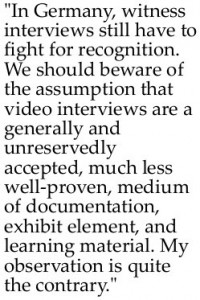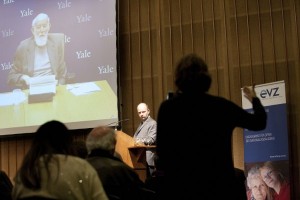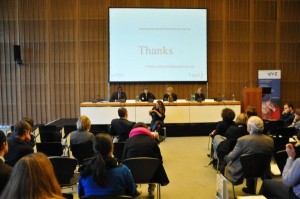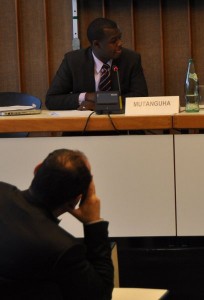How our culture of remembrance is changing in view of a disappearing generation of contemporary witnesses to World War II was the subject of a conference called “Preserving Survivors´ Memories – Digital Testimony Collections about Nazi Persecution” at the Haus der Kulturen der Welt in Berlin from 20 to 22 November 2012.
The conference was kicked off by Yale University comparative literature professor (emeritus) and Holocaust studies pioneer, Geoffrey Hartman. Born in Frankfurt in 1929, Hartman emigrated to England in 1939 as part of the refugee children’s movement. Together with his wife Renée, a survivor of the Bergen-Belsen concentration camp, he became involved in the founding of the Fortunoff Archive, which has recorded video interviews with Holocaust survivors since the 1970s. He views these video interviews as constituting a genre of their own, whose greatest significance comes from allowing survivors to speak for themselves.
A witness, himself, to the development of such testimonies and of the media used to capture them, from the early analog recordings to digitalization, right to today’s Web 2.0 presentation, Hartman also formulated his own theses about the future of the archive’s reception. He expressed his concern that in the age of a biographical video-clip boom – with the omnipresence of traumatic life stories on the internet – the “survivors’ clips” won’t have a long-lasting effect on future generations.
Today, the growing supply of digitalized testimonials offer new possibilities for use in research and teaching. Already today, innumerable video interviews on multimedia platforms such as “Iwitness” or the digital archive “Zwangsarbeit 1939–1945” (“Forced Labor 1939–1945”) are accessible at all times and from all places. But what consequences will this unlimited access have on the viewers, who listen to the survivors as “secondary witnesses”?
Conference participants compared notes on concepts, experiences, and the initial results of empirical research on the multimedia archives, in the areas of “audio-visual sources and archives,” “education,” and “visual media.” There was a consensus that presenting video testimonies in school classrooms cannot replace an actual discussion with a living witness, and also that the goal of using video interviews to teach schoolchildren should be reviewed thoroughly, so that the peculiarities of the medium are fully taken into account. Along these lines film scholar Gertrud Koch pointed to the characteristics of media – which are not, she argued, simply neutral vehicles for content, and which predetermine by their own form aspects of the content they convey. Nadine Fink, who explored what the exhibit “L’Histoire c’est moi – 555 Versions of Swiss History 1939-45” had to offer on the education front, found that pupils often subscribed to the prevailing historical discourse in Switzerland and ignored diverging reports from contemporary witnesses to history.

Michele Barricelli (Leibnitz University Hanover), member of the Program Committee of the conference (Organziers: EVZ – Stiftung Erinnerung, Verantwortung, Zukunft of the Free University Berlin and USC Shoah Foundation.)
During the final panel discussion moderated by Cilly Kugelmann on the theme “The Usage of Video Testimonies in Museums,” Suzanne Bardgett of the Imperial War Museum (London) called attention to the historicity of the video testimony medium: compilation films from old newsreel broadcasts and witness interviews in the Holocaust exhibit that opened in 2000 already give the impression of being historical, today. Diana Gring, the curator and director of the interview project for the memorial at Bergen-Belsen, illustrated the function of video in the permanent exhibition opened in 2007: with their visual presence, videos provide a counterweight to the world-famous photographs of mountains of corpses after the liberation. At the same time they serve historical research purposes, since there is no surviving (perpetrator-generated) photographic material from the camp.
At the end, Freddy Mutanguha presented the Kigali Memorial Center in Rwanda, which opened in 2004, ten years after the genocide there.
Today the documentation center is at once a mass grave for around 250,000 victims, and place of remembrance and learning. Mutanguha, who, himself, had to watch as his family was murdered, described how interviews are conducted with both victims as well as perpetrators. In an educational context he also works with interviews with Holocaust survivors. After first speaking about the German genocide, he found, the children of victims and perpetrators could discover how to speak with each other about their own history.
Katharina Obens, Visitor Research


